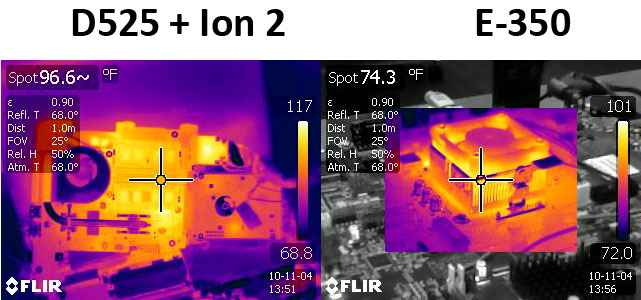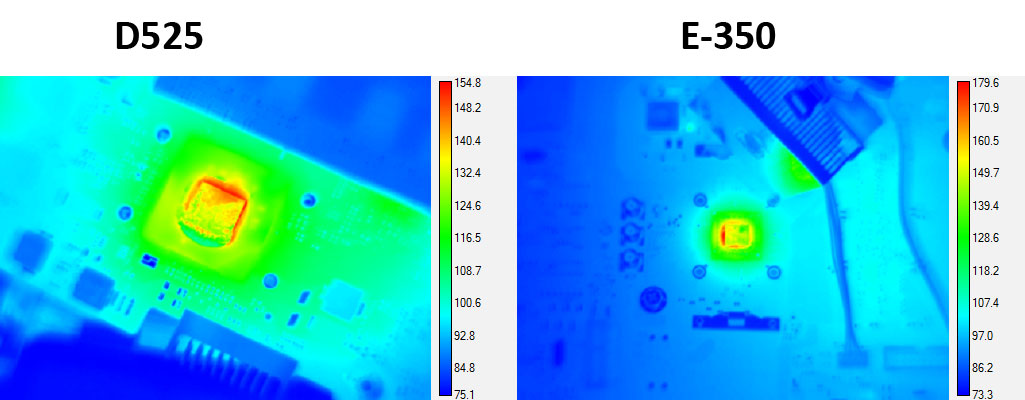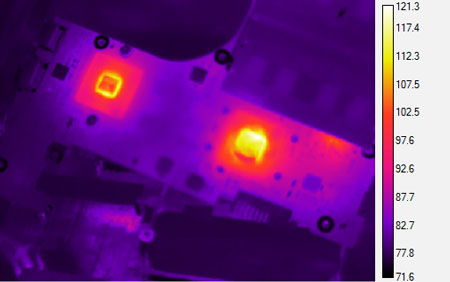AMD Fusion: Brazos Gets Previewed: Part 2, Performance
Zacate: Power And Heat
AMD is trying to make a point that it has power management figured out. Comparing the E-350 APU to the company's current Nile platform (K625 + 880G), there are clearly some serious improvements being touted through the Zacate part.
As far as we're concerned, the component level is less important than total platform power. Of course, we're interested in the power consumption of a mobile platform because that helps determine the amount of time we can spend away from a wall socket.
We crunched some numbers, and based on our typical use system power numbers, the E-350 comes in at 18.6 W. This is with the system's wireless adapter active, 12.1" LED LCD set at 100 nits, and utilizing Windows' Balanced setting. How does this compare to other similar CULV notebooks? Well, thankfully, we had two examples from Asus to put things in perspective.
The 1215N (Atom D525/Ion 2) and the 1215T (Athlon II Neo K125/Mobility Radeon HD 4225) are both 12.1" LCD CULV notebooks, and they're probably the most popular in the company's eeePC line. Arguably, this form factor has also been called "the premium netbook" and we don't necessarily disagree. But this is definitely part of the CULV notebook group that AMD is vectoring towards with Zacate.
AMD's demo platform didn't have a battery connection, so we had to rig up a Electrovaya PowerPad to measure DC wattage. In our typical use scenario (IE8 Web surfing), the E-350 falls behind the previous K125 and D525/Ion2 platform. AMD tells us it is still working on closing that gap. As this is a preproduction sample, we probably can expect upwards of 10-15% power savings on top of the 18 W. Based on our use, it seems that AMD may see the biggest power savings by playing with the GPU. At the moment, it seems to be operating at max clocks all of the time.
Heat is a more intesting story, as we took the picture above while the systems were idling. It is hard to draw a definitive statement based on these pictures, because we are looking at different PCB real estate, heatsink material, heatsink size, and so on. In order to look at things more closely, we took the following pictures of the processors unshielded roughly ~45 seconds after booting.
Even though the E-350 has a higher thermal footprint per area, that is understandable, given the fact that Intel's D525 doesn't have a powerful graphics core. Moreover, you would actually need to double the thermal footprint per area of the D525 if you took Nvidia's Ion2 chipset into account.
Get Tom's Hardware's best news and in-depth reviews, straight to your inbox.
For a CULV notebook, we don't hesitate to say that AMD has an amazing design given the lower proportional heat emissions. However, measured power consumption is still something to keep an eye on. At 18 W, the E-350 still consumes more power than what we would like to see from an AMD-based ULV processor.
In our preliminary tests, the Asus 1215N and the 1215T have similar battery life, but they get there via different approaches. The 1215N employs Nvidia's Optimus technology, which means that, at idle, its power consumption is similar to a vanilla Intel system. Meanwhile, even though the K125 is still a power hog, it has the driver support to dial back the IGP's clock rate.
Current page: Zacate: Power And Heat
Prev Page AMD Fusion: Brazos Recap, Power, And Heat Next Page Benchmark Results: Synthetics-
ares1214 Looking extremely impressive AMD, where as before you were a full gen behind, now id just say half gen. Make BD a big success, and you will most definitely get back in the game, however i doubt it would be enough to take the lead.Reply -
frederico If an Intel processor and an AMD processor were exactly the same - 9 out of 10 'normal' people would choose the IntelReply
The only people "in the know" are in the enthusiast segment of the market, which is a very small slice really.
Its a constant uphill battle for AMD, but then again, if they didn't exist, we'd all be paying through the nose for slower processors
-
I don't like when Tom's trow at us many facts from the AMD crowd to brainwash our mind. I don't like when the game is to convince the community to buy something who is not proved again.Reply
"The new AMD Fusion developer "trust fund" is actually a great way to start chipping away at the current CPU-heavy mentality." Yeas and we are also GPU-heavy mentality too!!!
-
tsnorquist killerclickWho the hell plays games on a netbook? Another spectacular fail for AMD.Reply
Probably not a lot of people, but when netbooks have the capability to play at acceptable levels for the masses, they will be great.
-
gxpbecker Nifty, an the best thing about AMD making high end competition for intel is price drops lol, if AMD can pull it off.Reply -
hannibal Even more interesting would be a tablet that can be used to play games!Reply
So it could mean that we can read e-mail, read e-books watch movies and internet pages and even play with tablet-PC. Netbook is just one step ahead... Yep it is not the same as Nvidia 460, even 350 or amd 5650 from the low end (gaming), but the resolution would be smaller, so it would be possible.
Let see what we get when this is really out.
All in all it gives people a choice. Need more CPU and very rarely GPU power... take intel... If you don't need so much CPU power, but need GPU power chose AMD. It's good to have altenatives!
-
K2N hater fredericoIf an Intel processor and an AMD processor were exactly the same - 9 out of 10 'normal' people would choose the IntelThe only people "in the know" are in the enthusiast segment of the market, which is a very small slice really.Its a constant uphill battle for AMD, but then again, if they didn't exist, we'd all be paying through the nose for slower processorsThe average user either picks Intel or Apple. And when the user picks Apple the CPU manufacturer is absolutely out of question.Reply





